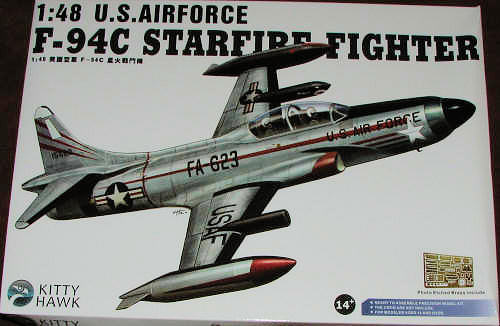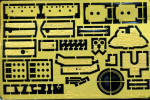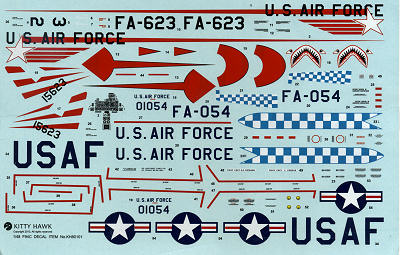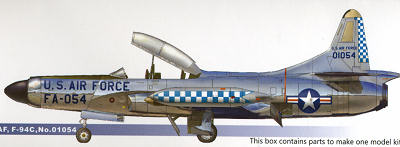
KittyHawk 1/48 F-94C Starfire
| KIT #: | KH80101 |
| PRICE: | $45.95 SRP |
| DECALS: | Two Options |
| REVIEWER: | Scott Van Aken |
| NOTES: | New tool kit with photoetch |

| HISTORY |
Starfire operational history.
In March 1951, F-94Bs were sent to combat in the Korean War, where they equipped the 339th, 68th, 4th, and 319th FIS. The type is credited with several air to air victories, including the first jet vs. jet night victory. One F-94 is listed as lost due to enemy action, six more to non-enemy causes on combat missions, two were declared as missing on a combat mission and three were lost in accidents. One F-94 was lost while slowing to 110 mph during an intercept of a Po-2 biplane.
Another early detachment was the 59th Fighter Interceptor Squadron, (all-weather, night-fighter interceptor,) which was sent to Goose Bay, Labrador in November, 1952 and placed under the control of Northeast Air Command (NEAC). One flight from the 59th FIS was kept at Thule Air Base to back up the DEW Line.
The F-94B remained in USAF service through 1954 before being transferred to the Air National Guard. In ANG service, some were modified with a pod under each wing for two additional .50 in (12.7 mm) machine guns, bringing the total to eight.
The first production F-94C aircraft were delivered in July 1951, 387 examples being delivered before May 1954. The largest problem discovered in service was that of the nose-mounted rockets which blinded the crew with their smoke and fire. The most severe problem of firing the nose-mounted rocket was that the exhaust could cause a flameout of the jet engine and could lead to the loss of the aircraft. Mid-wing fuel and rocket pods were added, each holding 12 rockets. Most of the time, the nose rockets were not installed, and the mid-wing pod rockets were the sole armament. This version of the aircraft was extensively used within the Semi Automatic Ground Environment (SAGE) air defense system.
The F-94C was retired from USAF service in 1959, as newer and more capable interceptors entered service. Air National Guard units retired their F-94s a year later.
| THE KIT |
 Nice to see a new company come into play and they have made a great choice for their first kit. The F-94C is one of those aircraft that enthusiasts have asked for over the years and while there have been several rumors and false starts, nothing new has made it to the buying public. Now that is over. Sure, there have been other F-94Cs on the market in this scale from resin makers and an ancient one from Lindberg, but this one is all up to modern specs.
Nice to see a new company come into play and they have made a great choice for their first kit. The F-94C is one of those aircraft that enthusiasts have asked for over the years and while there have been several rumors and false starts, nothing new has made it to the buying public. Now that is over. Sure, there have been other F-94Cs on the market in this scale from resin makers and an ancient one from Lindberg, but this one is all up to modern specs.
The kit is molded on three main sprues with a clear sprue added. The sprue for the wings was snipped in half as apparently it is a tad too long for the box. The molding on the kit is all that you could expect from a modern kit. Crisp engraved panel lines and well done rivet detail. The clear bits are actually quite clear. This one also includes a photo etch fret and three spherical weights to put into the nose. This latter item is not shown in the instructions, but it is obvious what they are for and they are quite welcome.
 The photo etch fret contains instrument panels, side consoles, interiors of the gear doors and speed brake (which help to make them properly thick), and a variety of other smaller bits and pieces. Some of these, such as the instrument panel, are not absolutely needed as decals are provided, but I think most will use them.
The photo etch fret contains instrument panels, side consoles, interiors of the gear doors and speed brake (which help to make them properly thick), and a variety of other smaller bits and pieces. Some of these, such as the instrument panel, are not absolutely needed as decals are provided, but I think most will use them.
Most previews start with the cockpit and so will I. There are two very nice early ejection seats and p.e. is used for the belts in these cases. The radar operator's position is well done with the scope molded in the upright position. There are also side panels for the front and back seats, each of which also accept some photo etch panels.
The speed brake wells are separate items that fit inside the aft fuselage along with the rear compressor/afterburner section. The speed brakes are shown being built open. Whether this is normal from ground ops, a check of photos will tell. Wheel wells and landing gear are also very nicely done with the nose gear attaching to the underside of the cockpit assembly. A separate main wheel well piece glues to the inside of the lower wing. Separate flaps are provided, but shown as being glued in the up position. Perhaps this is for the best as there are a number of ejector pin marks here that will need to be removed if shown lowered.
 A separate rudder is provided though the other flight control surfaces are molded into their respective flight surfaces. I like that this kit has a separate nose cone assembly as it makes it easier to install the nose weight at the end of the build. Of course, there are separate wing mounted rocket pods. These can be built with the pod nose cap in place or the rockets showing. Most of the time, the caps would be in place unless the aircraft was getting ready to fire. The canopy can be built open or closed.
A separate rudder is provided though the other flight control surfaces are molded into their respective flight surfaces. I like that this kit has a separate nose cone assembly as it makes it easier to install the nose weight at the end of the build. Of course, there are separate wing mounted rocket pods. These can be built with the pod nose cap in place or the rockets showing. Most of the time, the caps would be in place unless the aircraft was getting ready to fire. The canopy can be built open or closed.
Instructions are well done and use Gunze paint references. The bookl et has a full color cover and back section. In this latter is where you will find the decal and markings guide. Two options are provided. Neither one is identified as to unit and both are taken from museum planes. The box art aircraft is the one at the Pima museum and the other option is at the USAF museum. The decals themselves are superbly printed and probably very thin.
et has a full color cover and back section. In this latter is where you will find the decal and markings guide. Two options are provided. Neither one is identified as to unit and both are taken from museum planes. The box art aircraft is the one at the Pima museum and the other option is at the USAF museum. The decals themselves are superbly printed and probably very thin.
| CONCLUSIONS |
There are other interesting aircraft coming from these folks, but it is the first one that will tell how well they will do. This one is an excellent start. It is well made, an interesting subject, and test fitting has shown that the parts fit very well. The LHS sold out of their stock of these in less than a week, so you know it is something modelers have been looking for. I will be building this one so stay tuned.
| REFERENCES |
July 2012
Thanks to Kitty Hawk for the review kit. If you would like your product reviewed fairly and fairly quickly , please contactthe editor or see other details in the